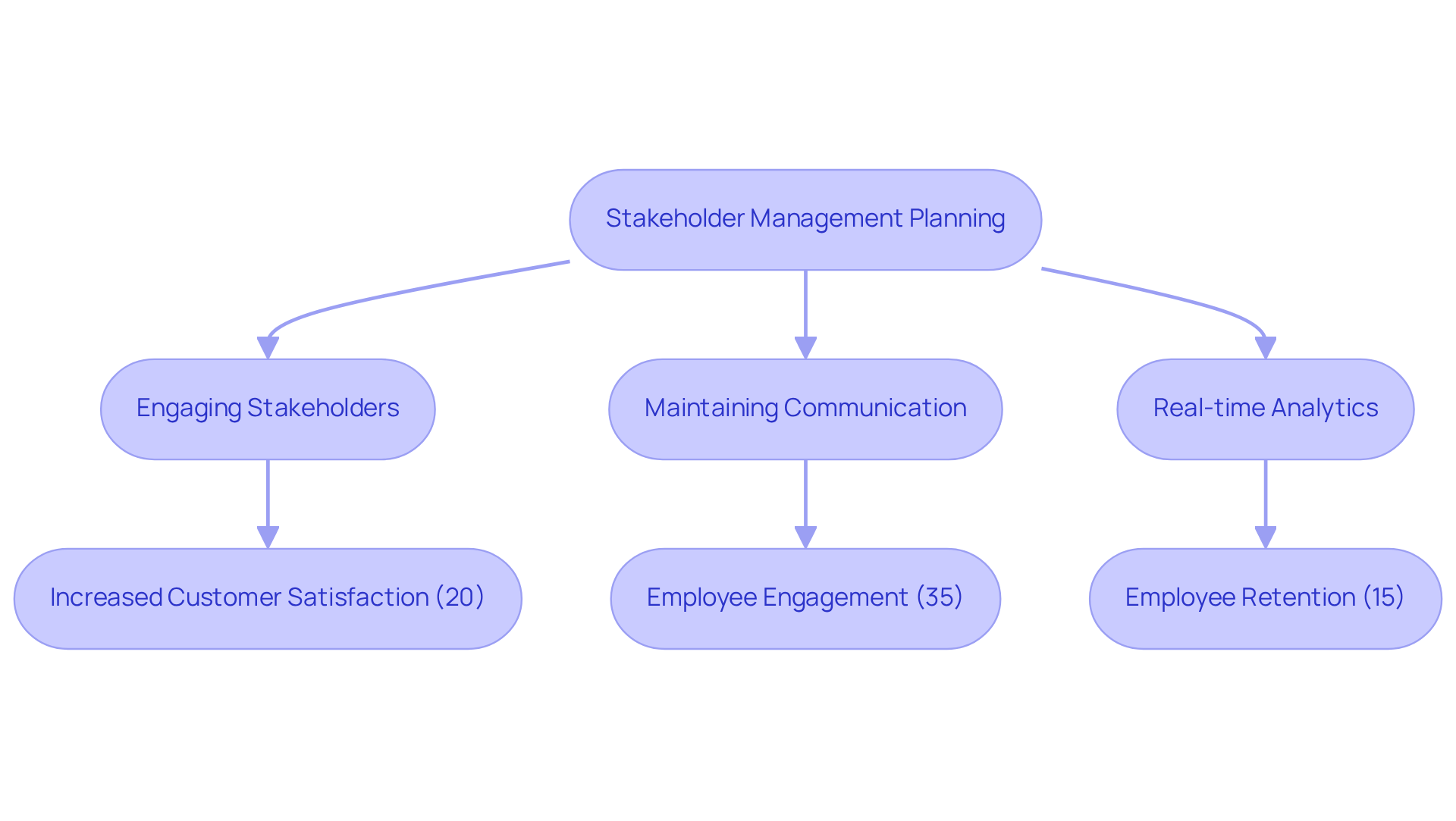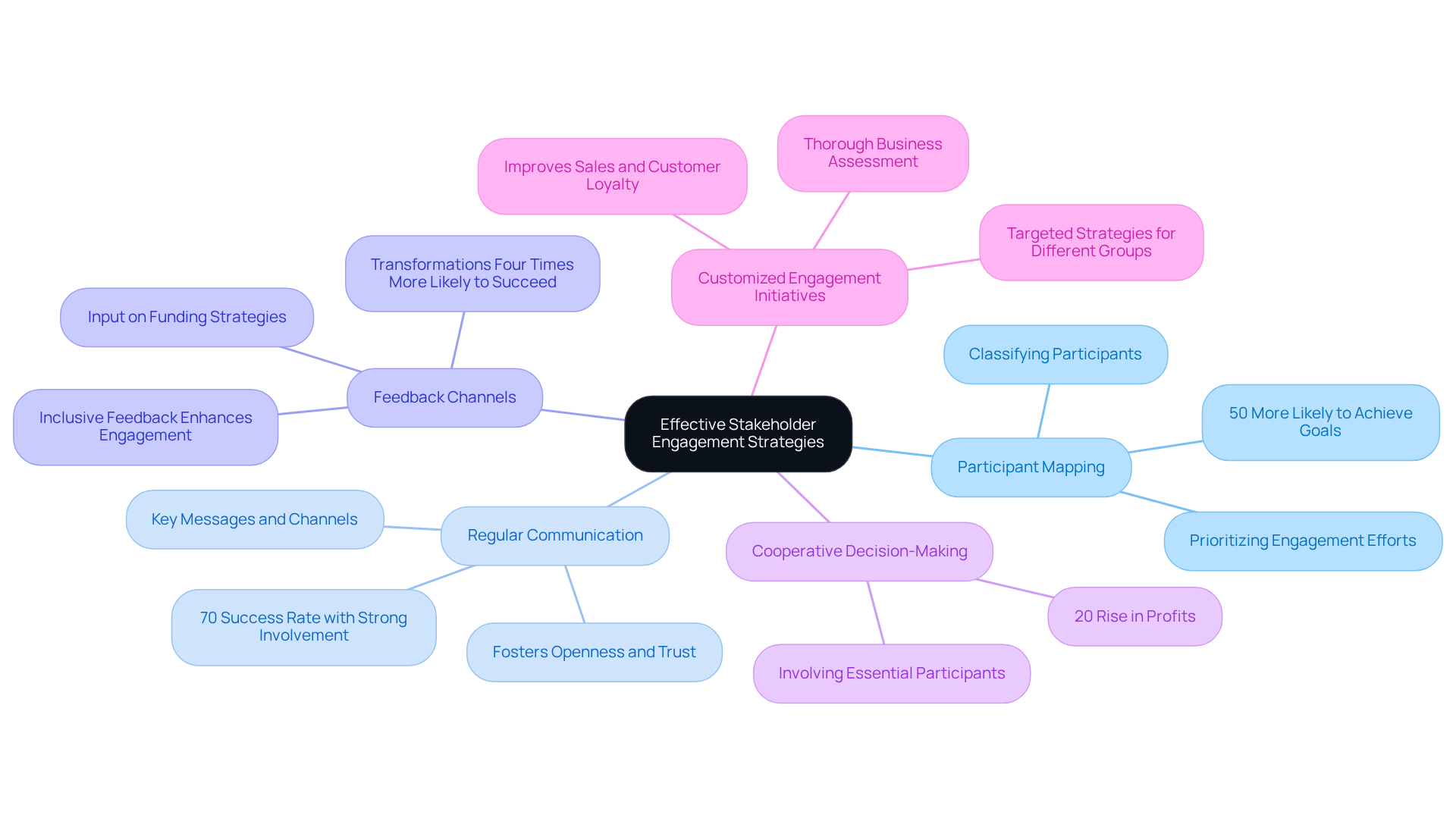Overview
Effective stakeholder management planning hinges on three key strategies:
- Participant mapping
- Regular communication
- Feedback channels
These strategies are not merely suggestions; they are essential components that enhance engagement and collaboration. Research has consistently shown that when stakeholders are actively involved, project success rates improve, and organizational performance increases. This is evidenced by higher customer satisfaction and employee retention. Therefore, it is imperative to implement these strategies to foster a thriving organizational environment.
Introduction
Effective stakeholder management transcends mere buzzwords; it is a vital element of strategic success, especially for CFOs navigating intricate business landscapes. By mastering the art of stakeholder engagement, financial leaders can unlock substantial benefits, such as enhanced trust, improved project outcomes, and increased profitability.
However, the challenge lies in identifying the most effective strategies to ensure that all voices are heard and aligned with organizational goals. What key approaches can transform stakeholder interactions into a powerful driver of financial success?
Define Stakeholder Management and Its Importance for CFOs
Stakeholder management planning is a systematic approach that involves identifying, analyzing, and engaging individuals or groups with an interest in or affected by a company's operations. For CFOs, understanding this concept is crucial, as it directly influences performance and strategic decision-making. Efficient management of involved parties ensures that the concerns of key stakeholders—such as investors, employees, customers, and regulatory bodies—align with the organization's economic objectives. By fostering strong relationships and maintaining open communication channels, CFOs can mitigate risks, enhance trust, and ultimately drive economic success.
In today’s fast-paced business landscape, a streamlined decision-making cycle is imperative. Our team facilitates this by empowering decisive actions throughout the turnaround process, enabling CFOs to respond swiftly to the needs of stakeholders. Additionally, continuous monitoring of business performance through real-time analytics is vital. Utilizing client dashboards that deliver real-time business insights allows CFOs to consistently assess their business health and operationalize lessons learned from the turnaround process.
Research indicates that organizations implementing effective stakeholder management planning experience:
- A 20% increase in customer satisfaction
- A 35% increase in employee engagement
- A 15% increase in employee retention
All contributing to improved economic outcomes. Furthermore, effective stakeholder engagement can lead to a 40% reduction in project delays and higher project success rates, highlighting its importance in achieving project success and maximizing return on investment. Thus, for financial leaders, prioritizing stakeholder management planning is not merely beneficial; it is a strategic necessity that fosters sustainable growth and enhances overall organizational performance. As Mojtaba Gholmohammadi Shooraki states, 'Research evidence demonstrates a significant positive connection between firm performance and management of involved parties.' Moreover, case studies, such as Interface's commitment to sustainability, exemplify the tangible benefits of effective stakeholder involvement.

Implement Effective Stakeholder Engagement Strategies
To effectively engage stakeholders, CFOs must adopt a multi-faceted approach that encompasses several strategic elements:
-
Participant Mapping: Recognizing and classifying participants according to their influence and interest levels is crucial. This process supports stakeholder management planning by helping prioritize engagement efforts and tailor communication strategies accordingly. Companies that interact with interested parties are 50% more likely to accomplish their major objectives, underscoring the importance of this essential step.
-
Regular Communication: Developing a communication strategy that specifies key messages, channels, and update frequency for each group of interested parties is vital. Regular communication fosters openness and cultivates trust, which is essential for successful stakeholder management planning. Projects with strong involvement boast a 70% success rate, highlighting the critical need for maintaining open lines of communication.
-
Feedback Channels: Establishing systems for participants to provide input on funding strategies and initiatives not only enhances engagement but also allows for modifications based on contributor feedback. Engaging key employees in stakeholder management planning can make transformations four times more likely to succeed, demonstrating the power of inclusive feedback.
-
Stakeholder management planning involves including essential participants in the decision-making process, particularly for major financial choices, which can lead to greater buy-in and support for initiatives. Studies reveal that firms with robust connections to their interested parties experience a 20% rise in profits, emphasizing the significance of cooperative decision-making.
-
Customized Engagement Initiatives: Creating specific initiatives focused on addressing the unique concerns of various interest groups, such as workshops for employees or briefings for investors, can significantly enhance relationships. This targeted strategy not only improves engagement but also aligns with stakeholder management planning to support financial goals. For instance, companies that successfully involve interested parties often see a rise in sales and customer loyalty, further confirming the necessity for customized interaction strategies. Moreover, initiating each client interaction with a thorough business assessment fosters a deeper understanding of the business context, allowing CFOs to align essential participants efficiently and address fundamental issues. By implementing insights gained during the turnaround process, CFOs can cultivate strong, lasting connections that contribute to ongoing business success.

Monitor and Adapt Stakeholder Management Plans for Financial Success
Monitoring and adapting stakeholder management planning is crucial for fostering effective relationships and achieving financial success. CFOs should implement the following best practices:
- Regular Assessment: Periodically evaluate participant involvement strategies to gauge their effectiveness. This involves analyzing feedback, engagement levels, and overall satisfaction among involved parties, ensuring alignment with organizational goals. Utilizing the client dashboard for real-time business analytics can enhance this process.
- Adjust Communication Strategies: Be ready to modify communication approaches based on input from involved parties and evolving circumstances. Flexibility in communication helps address emerging concerns and sustains trust, which is vital for long-term relationships. Emphasizing a commitment to partnership can further strengthen these connections.
- Performance Metrics: Establish key performance indicators (KPIs) to assess the success of participant involvement efforts. Measurements like participant satisfaction scores and involvement levels offer important insights for ongoing enhancement and strategic alignment. Projects with high engagement have a 70% success rate, underscoring the need for effective measurement. Utilizing real-time business analytics can further enhance this process, allowing for timely adjustments based on performance data.
- Crisis Management Plans: Create contingency plans for handling relationships with interested parties during financial crises. A proactive strategy can reduce risks and uphold confidence among parties involved, ensuring stability during difficult times. Streamlined decision-making processes can facilitate quicker responses in such scenarios.
- Continuous Learning: Stay informed on best practices in managing partners and adapt strategies accordingly. Engaging with industry peers and participating in relevant training enhances the CFO's capability to manage stakeholder relationships effectively, fostering a culture of adaptability and resilience.
Conclusion
Effective stakeholder management is not merely a beneficial practice for CFOs; it is a fundamental pillar underpinning strategic success and sustainable growth within an organization. By understanding and implementing robust stakeholder management planning, financial leaders can ensure a harmonious alignment of the interests of investors, employees, customers, and regulatory bodies with the company’s economic objectives. This alignment fosters trust, mitigates risks, and ultimately enhances organizational performance.
The article outlines three key strategies for achieving effective stakeholder management:
- Defining and engaging stakeholders
- Monitoring and adapting management plans
- Employing tailored communication strategies
Each of these strategies underscores the importance of recognizing stakeholder influence, maintaining open lines of communication, and continuously assessing engagement effectiveness. The data presented highlights tangible benefits of these practices, including increased customer satisfaction, employee engagement, and overall project success rates, reinforcing that a strategic approach to stakeholder management is crucial for financial leaders.
In a landscape where stakeholder expectations are ever-evolving, CFOs must embrace these strategies not just as best practices but as essential components of their operational framework. By prioritizing stakeholder management, organizations can unlock greater economic potential, foster lasting relationships, and navigate challenges with resilience. The time to act is now; integrating these insights into stakeholder management practices will pave the way for sustained financial success and a thriving organizational culture.
Frequently Asked Questions
What is stakeholder management?
Stakeholder management is a systematic approach that involves identifying, analyzing, and engaging individuals or groups with an interest in or affected by a company's operations.
Why is stakeholder management important for CFOs?
For CFOs, understanding stakeholder management is crucial as it directly influences performance and strategic decision-making, ensuring that the concerns of key stakeholders align with the organization's economic objectives.
How does effective stakeholder management benefit organizations?
Organizations that implement effective stakeholder management experience a 20% increase in customer satisfaction, a 35% increase in employee engagement, and a 15% increase in employee retention, all contributing to improved economic outcomes.
What impact does stakeholder engagement have on project success?
Effective stakeholder engagement can lead to a 40% reduction in project delays and higher project success rates, highlighting its importance in achieving project success and maximizing return on investment.
What tools can CFOs use to monitor business performance?
CFOs can utilize client dashboards that deliver real-time business insights to consistently assess their business health and operationalize lessons learned from the turnaround process.
How does stakeholder management influence decision-making in a fast-paced business environment?
Streamlined decision-making is imperative in today's fast-paced business landscape. By empowering decisive actions throughout the turnaround process, CFOs can respond swiftly to the needs of stakeholders.
What does research indicate about the relationship between stakeholder management and firm performance?
Research evidence demonstrates a significant positive connection between firm performance and the management of involved parties, emphasizing the strategic necessity of stakeholder management for financial leaders.
Can you provide an example of effective stakeholder involvement?
A case study highlighting effective stakeholder involvement is Interface's commitment to sustainability, which exemplifies the tangible benefits that can arise from strong stakeholder engagement.




